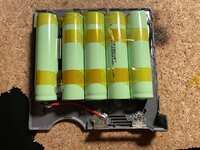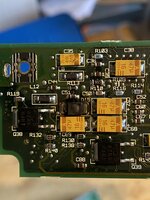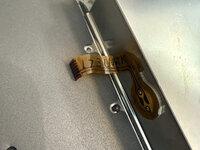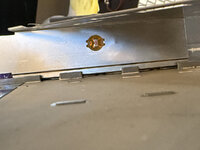You are using an out of date browser. It may not display this or other websites correctly.
You should upgrade or use an alternative browser.
You should upgrade or use an alternative browser.
PowerBook 160 Repairs
- Thread starter jmacz
- Start date
3lectr1cPPC
Well-known member
Would A cells fit? You mentioned the dimensions of the original cells earlier - is that A size?
jmacz
Well-known member
The original cells were A size so yes they would fit. But it would be a much tighter fit. Length wise A and AA are the same (50mm). But diameter wise the A is 17mm whereas the AA is 14mm. So the AAs are much more forgiving routing the wires etc whereas the A would be a really tight fit when putting it back together.
3lectr1cPPC
Well-known member
Good to know. I have cracked an aftermarket pack over (and it uses A cells) but wasn’t sure if the OEM pack did. Aftermarket pack is from 2004 but the cells are already leaking…
jmacz
Well-known member
Well, results are mediocre I think... I fully charged the battery and then left the machine running with full brightness, sleep disabled, configured to not allow the SCSI2SD to sleep. But I wasn't using it - left it sitting there at full brightness. Lasted about 1 hour 20 minutes. It's fine for now, at least I have something functional and it's not like I'm going to be heavily using this PowerBook.
I did run into another issue though. Even before I started mucking with the battery, the drive (SCSI2SD) was flaking out a bit. Every so often, it would not detect on boot. This afternoon as I was installing a fresh System 7.1.1 on it, it wasn't detecting for a while. But I was eventually able to do the install. Just tried booting again after letting it sit for a bit and I cannot get the drive to detect at all on boot... just getting the question mark disk icon. Will have to take this apart and figure out what's going on with it.
I did run into another issue though. Even before I started mucking with the battery, the drive (SCSI2SD) was flaking out a bit. Every so often, it would not detect on boot. This afternoon as I was installing a fresh System 7.1.1 on it, it wasn't detecting for a while. But I was eventually able to do the install. Just tried booting again after letting it sit for a bit and I cannot get the drive to detect at all on boot... just getting the question mark disk icon. Will have to take this apart and figure out what's going on with it.
jmacz
Well-known member
I used battery amnesia to fully drain the battery. Right before system shutdown, battery amnesia was reporting a voltage reading of 5.66V from the battery. Then the power shut off. With the battery out of the laptop and no load, it reads about 6.09V. I then booted with the power supply and inserted the battery to charge it. The battery meter (I'm using both the battery desk accessory as well as a utility called mybattery - made by the same author as battery amnesia) and it's showing the battery is half full, voltage is up at 6.14V and starts climbing. Strange.
I think I had read that capacities aside, the difference between an A battery, AA battery, and AAA battery is voltage drop under load. It could well be that with the AA, the voltage is dropping enough where the system shuts off. Maybe there's less of a drop with an A size cell?
I found some new Sanyo A size NiCDs online, 1700 mAH. So a pack with two parallel sets should provide 3400mAH total capacity which is larger than the stock 2800mAH. Fairly pricey ($3/each).
I think I had read that capacities aside, the difference between an A battery, AA battery, and AAA battery is voltage drop under load. It could well be that with the AA, the voltage is dropping enough where the system shuts off. Maybe there's less of a drop with an A size cell?
I found some new Sanyo A size NiCDs online, 1700 mAH. So a pack with two parallel sets should provide 3400mAH total capacity which is larger than the stock 2800mAH. Fairly pricey ($3/each).
croissantking
Well-known member
I used battery amnesia to fully drain the battery. Right before system shutdown, battery amnesia was reporting a voltage reading of 5.66V from the battery. Then the power shut off. With the battery out of the laptop and no load, it reads about 6.09V. I then booted with the power supply and inserted the battery to charge it. The battery meter (I'm using both the battery desk accessory as well as a utility called mybattery - made by the same author as battery amnesia) and it's showing the battery is half full, voltage is up at 6.14V and starts climbing. Strange.
I think I had read that capacities aside, the difference between an A battery, AA battery, and AAA battery is voltage drop under load. It could well be that with the AA, the voltage is dropping enough where the system shuts off. Maybe there's less of a drop with an A size cell?
I found some new Sanyo A size NiCDs online, 1700 mAH. So a pack with two parallel sets should provide 3400mAH total capacity which is larger than the stock 2800mAH. Fairly pricey ($3/each).

Just for reference, this is the design I went for in two of my rebuilds using 4/3 A NiMH cells. I had planned to use 10x A cells but had trouble with fitment as I didn’t have access to a spot welder at the time. Clearance is very tight with the original configuration so getting the cells welded together tightly is crucial and you just can’t achieve that when you solder them together.
Performance is OK, they sometimes don’t seem to fully charge up so runtime feels a bit inconsistent. One of the packs seems to work a bit better than the other in terms of runtime despite being the same design. These cells are definitely not premium quality however I used the same type of A cells originally designated for this battery in my PB1400c with very good results.
There doesn’t seem to be a lot of choice as regards purchasing new A or 4/3A size NiMH cells in the UK. It was either getting these ones for about £2-3 off a seller on eBay or paying upwards of £10 each for them for brand name cells from RS Components, Mouser etc.
Last edited:
jmacz
Well-known member
Just closing the loop on this. My rebuilt battery pack with "A" sized cells (10 of them) is working fine, as long as it's charged externally via an external charger. I am getting about 80-90 minutes of use out of a fully charged battery which seems fine.
Charging within the laptop doesn't work however and I'm not sure why.
The battery pack (fully charged externally) powers the laptop so I know all the connections are fine. Charging via the laptop however delivers some charge but it stops charging with the system saying it's at 100% but it's clearly not. The battery isn't smart, it only has power and ground connections, so all status monitoring is being done via the voltage. I don't know why it doesn't charge properly via the laptop. It can't be a faulty voltage detection either as the voltage is detected just fine when the battery has been charged externally. All I can think of is some diode that allows power to flow from the power adapter into the battery is malfunctioning .. assuming it's a diode since power going the other way (from battery to the system) is fine.
Charging within the laptop doesn't work however and I'm not sure why.
The battery pack (fully charged externally) powers the laptop so I know all the connections are fine. Charging via the laptop however delivers some charge but it stops charging with the system saying it's at 100% but it's clearly not. The battery isn't smart, it only has power and ground connections, so all status monitoring is being done via the voltage. I don't know why it doesn't charge properly via the laptop. It can't be a faulty voltage detection either as the voltage is detected just fine when the battery has been charged externally. All I can think of is some diode that allows power to flow from the power adapter into the battery is malfunctioning .. assuming it's a diode since power going the other way (from battery to the system) is fine.
croissantking
Well-known member
Just closing the loop on this. My rebuilt battery pack with "A" sized cells (10 of them) is working fine, as long as it's charged externally via an external charger. I am getting about 80-90 minutes of use out of a fully charged battery which seems fine.
Charging within the laptop doesn't work however and I'm not sure why.
The battery pack (fully charged externally) powers the laptop so I know all the connections are fine. Charging via the laptop however delivers some charge but it stops charging with the system saying it's at 100% but it's clearly not. The battery isn't smart, it only has power and ground connections, so all status monitoring is being done via the voltage. I don't know why it doesn't charge properly via the laptop. It can't be a faulty voltage detection either as the voltage is detected just fine when the battery has been charged externally. All I can think of is some diode that allows power to flow from the power adapter into the battery is malfunctioning .. assuming it's a diode since power going the other way (from battery to the system) is fine.
Just a wild thought but diode D15 often fails on these machines, near the power jack. Worth a check?

jmacz
Well-known member
Just a wild thought but diode D15 often fails on these machines, near the power jack. Worth a check?
Thanks for the lead. Will check it out.
jmacz
Well-known member
Just a wild thought but diode D15 often fails on these machines, near the power jack. Worth a check?
D15 checked out. Physically looks good and also tested ok.
With the main board (the one with the power jack and power button) out of the laptop, I plugged it in and tested the voltage at the battery pin (with battery removed) and it showed around 7.6V which looks good. So power delivery is getting to the battery terminals. Just not sure what's causing the battery to not fully charge.
While I was in there, I noticed this weird thing sitting on the side of the metal cage that houses the battery.

This connects to the main logic board. Here's a view from inside the battery compartment:

It looks like a plain resistor (104) which is 100kOhms. I tested the resistance on that resistor and it's at around 88kOhms which seems ok assuming 10% tolerance.
But I don't see what it's purpose is? I tested continuity from the resistor to the ribbon connector on the board and that's good. It also has continuity to a couple other points on the main board, so that's good too. But I'm not sure I understand what it's doing? Perhaps it's a placeholder for a thermal sensor that wasn't yet supported on this PB 160? Note there's nothing on the battery that would interface with this thing.
The current state is still that the rebuilt battery charges with an external charger to full charge. The laptop can use this charged battery and lasts around 90 minutes via battery amnesia draining it (which means it was charged). This means the laptop sees the battery and gets full use out of it. The battery terminal inside the laptop does see the full 7.6-7.7V from the power brick. Yet the battery won't charge fully when inserted into the laptop.
3lectr1cPPC
Well-known member
That is definitely related to battery charging and I doubt it would charge a battery without that plugged in. You're saying it still won't charge with this plugged in?
jmacz
Well-known member
That is definitely related to battery charging and I doubt it would charge a battery without that plugged in. You're saying it still won't charge with this plugged in?
It's definitely plugged in. I was saying that I tested continuity to it (which was good), and I checked the resistance of the resistor (which is also good). So whatever it is, it's plugged in, has continuity, and the indicated resistance (albeit 10% off).
I was just curious what it does mounted in that position. It looks like a standard SMD resistor.
3lectr1cPPC
Well-known member
service source says it’s a thermistor.
mdeverhart
Well-known member
Googling for “104 thermistor” shows that would designate a thermistor with 100k ohm resistance at 25C, and you should be able to measure your existing one to get the dimensions for a replacement. The tricky part is figuring out the B value of the original, which describes the curve for how the resistance changes as the temperature changes.
Similar threads
- Replies
- 65
- Views
- 5K
- Replies
- 2
- Views
- 572
- Replies
- 2
- Views
- 293
